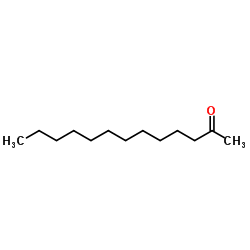2-十三烷酮

2-十三烷酮结构式

|
常用名 | 2-十三烷酮 | 英文名 | 2-Tridecanone |
|---|---|---|---|---|
| CAS号 | 593-08-8 | 分子量 | 198.345 | |
| 密度 | 0.8±0.1 g/cm3 | 沸点 | 263.8±3.0 °C at 760 mmHg | |
| 分子式 | C13H26O | 熔点 | 24-27 °C(lit.) | |
| MSDS | 中文版 美版 | 闪点 | 83.3±12.6 °C | |
| 符号 |

GHS09 |
信号词 | Warning |
|
Olfactometry Profiles and Quantitation of Volatile Sulfur Compounds of Swiss Tilsit Cheeses.
J. Agric. Food Chem. 63 , 7511-21, (2015) To establish the odor profiles of three differently fabricated commercial Swiss Tilsit cheeses, analyses were conducted using headspace solid-phase microextraction gas chromatography-mass spectrometry/pulsed flame photometric detection and gas chromatography-... |
|
|
Diacetin, a reliable cue and private communication channel in a specialized pollination system.
Sci. Rep. 5 , 12779, (2015) The interaction between floral oil secreting plants and oil-collecting bees is one of the most specialized of all pollination mutualisms. Yet, the specific stimuli used by the bees to locate their host flowers have remained elusive. This study identifies diac... |
|
|
Synthesis of methyl ketones by metabolically engineered Escherichia coli.
J. Ind. Microbiol. Biotechnol. 39(11) , 1703-12, (2012) Methyl ketones are a group of highly reduced platform chemicals with widespread applications in the fragrance, flavor and pharmacological industries. Current methods for the industrial production of methyl ketones include oxidation of hydrocarbons, but recent... |
|
|
Test of the Binding Threshold Hypothesis for olfactory receptors: explanation of the differential binding of ketones to the mouse and human orthologs of olfactory receptor 912-93.
Protein Sci. 14(3) , 703-10, (2005) We tested the Binding Threshold Hypothesis (BTH) for activation of olfactory receptors (ORs): To activate an OR, the odorant must bind to the OR with binding energy above some threshold value. The olfactory receptor (OR) 912-93 is known experimentally to be a... |
|
|
Insecticidal activity of 2-tridecanone against the cowpea weevil Callosobruchus maculatus (Coleoptera: Bruchidae).
An. Acad. Bras. Ciênc. 79(1) , 35-9, (2007) The effect of 2-tridecanone vapor on the cowpea weevil (Callosobruchus maculatus) development was determined. Seeds of cowpea were infested with adults and exposed to different doses of 2-tridecanone isolated from Pilocarpus microphyllus Stapf ex Holm, a plan... |
|
|
2-undecanone and 2-tridecanone in field-grown onion.
J. Environ. Sci. Health B 48(4) , 302-7, (2013) A field study was conducted to investigate the impact of soil amendments on concentrations of two volatile organic compounds, 2-undecanone and 2-tridecanone, in onion bulbs. The soil in five plots was mixed with sewage sludge, five plots were mixed with yard ... |
|
|
Accumulation and turnover of 2-tridecanone in Tetranychus urticae and its consequences for resistance of wild and cultivated tomatoes.
Exp. Appl. Acarol. 23(12) , 1011-21, (1999) In this study we assessed the dynamic changes of 2-tridecanone in a herbivorous mite (Tetranychus urticae) on tomato (Lycopersicon esculentum, cv. 'Moneymaker'), a plant with methyl ketones in the tetracellular tips of the glandular trichomes (Type VI). We sh... |
|
|
Enzymatic functions of wild tomato methylketone synthases 1 and 2.
Plant Physiol. 154(1) , 67-77, (2010) The trichomes of the wild tomato species Solanum habrochaites subsp. glabratum synthesize and store high levels of methylketones, primarily 2-tridecanone and 2-undecanone, that protect the plants against various herbivorous insects. Previously, we identified ... |
|
|
Engineering of bacterial methyl ketone synthesis for biofuels.
Appl. Environ. Microbiol. 78(1) , 70-80, (2012) We have engineered Escherichia coli to overproduce saturated and monounsaturated aliphatic methyl ketones in the C₁₁ to C₁₅ (diesel) range; this group of methyl ketones includes 2-undecanone and 2-tridecanone, which are of importance to the flavor and fragran... |
|
|
Mandibular gland secretions of meliponine worker bees: further evidence for their role in interspecific and intraspecific defence and aggression and against their role in food source signalling.
J. Exp. Biol. 212(Pt 8) , 1153-62, (2009) Like ants and termites some species of stingless bees (Meliponini), which are very important pollinators in the tropics, use pheromone trails to communicate the location of a food source. We present data on the communicative role of mandibular gland secretion... |